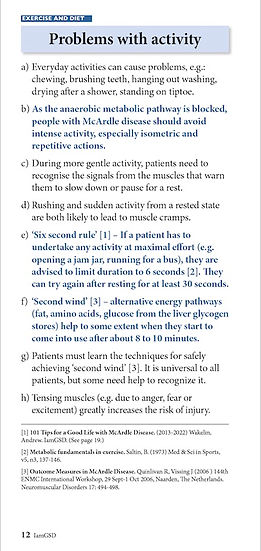
McArdle Disease medical overview
Please note that this translation is automated and may not be perfect.
Page 12

Page 12
EXERCISE AND DIET
Problems with activity
Everyday activities can cause problems, e.g.: chewing, brushing teeth, hanging out washing, drying after a shower, standing on tiptoe.
As the anaerobic metabolic pathway is blocked, people with McArdle disease should avoid intense activity, especially isometric and repetitive actions.
During more gentle activity, patients need to recognise the signals from the muscles that warn them to slow down or pause for a rest.
Rushing and sudden activity from a rested state are both likely to lead to muscle cramps.
‘Six second rule’ [1] – If a patient has to undertake any activity at maximal effort (e.g. opening a jam jar, running for a bus), they are advised to limit duration to 6 seconds [2]. They can try again after resting for at least 30 seconds.
‘Second wind’ [3] – alternative energy pathways (fat, amino acids, glucose from the liver glycogen stores) help to some extent when they start to come into use after about 8 to 10 minutes.
Patients must learn the techniques for safely achieving ‘second wind’ [3]. It is universal to all patients, but some need help to recognize it.
Tensing muscles (e.g. due to anger, fear or excitement) greatly increases the risk of injury.
[1] 101 Tips for a Good Life with McArdle Disease. (2013-2022) Wakelin, Andrew. IamGSD. (See page 19.)
[2] Metabolic fundamentals in exercise. Saltin, B. (1973) Med & Sci in Sports, v5, n3, 137-146.
[3] Outcome Measures in McArdle Disease. Quinlivan R, Vissing J (2006 ) 144th ENMC International Workshop, 29 Sept-1 Oct 2006, Naarden, The Netherlands. Neuromuscular Disorders 17: 494-498.
McArdle Disease Medical Overview
IamGSD
